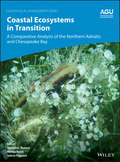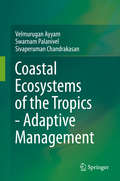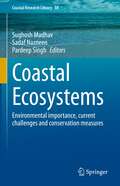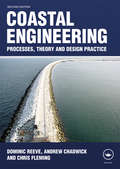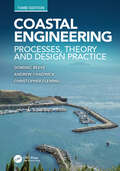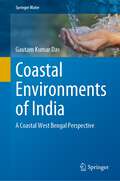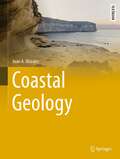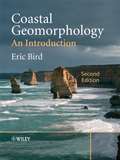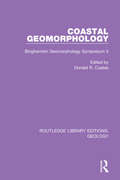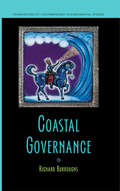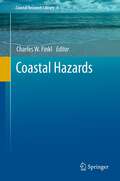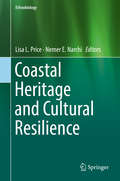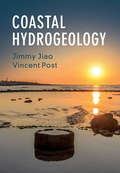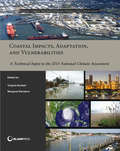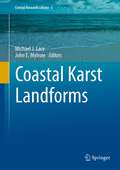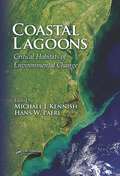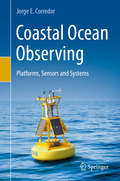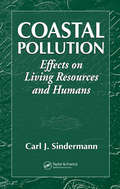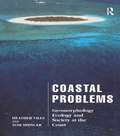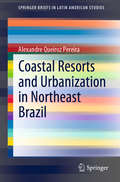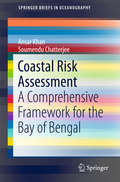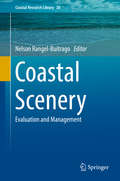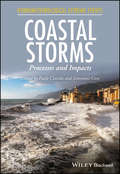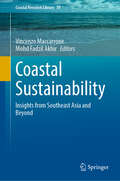- Table View
- List View
Coastal Ecosystems in Transition: A Comparative Analysis of the Northern Adriatic and Chesapeake Bay (Geophysical Monograph Series #256)
by Thomas C. Malone Alenka Malej Jadran FaganeliExplores how two coastal ecosystems are responding to the pressures of human expansion The Northern Adriatic Sea, a continental shelf ecosystem in the Northeast Mediterranean Sea, and the Chesapeake Bay, a major estuary of the mid-Atlantic coast of the United States, are semi-enclosed, river-dominated ecosystems with urbanized watersheds that support extensive industrial agriculture. Coastal Ecosystems in Transition: A Comparative Analysis of the Northern Adriatic and Chesapeake Bay presents an update of a study published two decades ago. Revisiting these two ecosystems provides an opportunity to assess changing anthropogenic pressures in the context of global climate change. The new insights can be used to inform ecosystem-based approaches to sustainable development of coastal environments. Volume highlights include: Effects of nutrient enrichment and climate-driven changes on critical coastal habitats Patterns of stratification and circulation Food web dynamics from phytoplankton to fish Nutrient cycling, water quality, and harmful algal events Causes and consequences of interannual variability The American Geophysical Union promotes discovery in Earth and space science for the benefit of humanity. Its publications disseminate scientific knowledge and provide resources for researchers, students, and professionals.
Coastal Ecosystems of the Tropics - Adaptive Management
by Velmurugan Ayyam Swarnam Palanivel Sivaperuman ChandrakasanThe coastal areas of the tropics are rich in biodiversity, natural resources and place of intensive developmental activities as it provides livelihood to millions of people. At the same time evidences suggest that several unique coastal ecosystems viz., mangroves, wetlands, salt marshes, corals, estuaries, sand dunes and agro-ecosystem are vulnerable to natural disasters and events associated with global climate change. In recent times degradation of land, water and genetic erosion besides threat to native flora and fauna have been increasing due to unsustainable developmental activities. Therefore, a paradigm shift in deriving livelihood through conventional methods, developmental strategies, conservation practices are required for balanced and sustainable growth of the coastal areas. This publication strives to cover the status of different natural resources of the coastal region, various aspects of degradation process, production need and restorative methods besides new technological options and its socio-economic implications with case examples. Special focus is given to bring out the scope and potential of mangrove based farming, integrated and organic farming and its value addition besides the role of coastal vegetations as bioshield in protecting these regions from sea erosion, cyclones and tsunami. As the tropical coastal areas are vulnerable to climate change events, this book also covers the recent weather pattern, impacts of climate change and climate resilient technologies besides intuitional linkages and policy framework aimed at balancing development and environmental concerns.
Coastal Ecosystems: Environmental importance, current challenges and conservation measures (Coastal Research Library #38)
by Pardeep Singh Sughosh Madhav Sadaf NazneenThis volume incorporates theoretical and practical knowledge through case studies and reviews to serve as a baseline of information for coastal ecosystem research, and discusses the impacts of pollution, industrialisation, agriculture and climate change on coastal ecosystem biogeochemistry and biodiversity. The case studies address the role of coastal ecosystems as a carbon sink which is getting impacted by anthropogenic disturbances. Through this analysis, the book covers various strategies for the conservation and management of coastal ecosystems, considering their unique ecological and biogeochemical attributes and region-specific threats and impacts. The book will be of interest to a wide range of readers including students, researchers and professionals in coastal ecosystem science, coastal pollution, climate change adaptation, biodiversity conservation and environmental management.
Coastal Engineering: Processes, Theory and Design Practice
by Andrew Chadwick Dominic Reeve Christopher FlemingHistorically, much harm has been done by well-meaning coastal engineering attempts, which seemed like good ideas on paper but which failed to allow for practical issues. For this reason, it is vital that theories and models are well grounded in practice. This second edition brings the models and examples of practice up to date. It has expanded coverage of tsunamis and generating energy from waves to focus both on the great dangers and the great opportunities that the ocean presents to the coastal zone. With an emphasis on practice and detailed modelling, this is a thorough introduction to all aspects of coastal processes, morphology, and design of coastal defences. It describes numerous case studies to illustrate the successful application of mathematical modelling to real-world practice. A must-have book for engineering students looking to specialize in coastal engineering and management.
Coastal Engineering: Processes, Theory and Design Practice
by Andrew Chadwick Dominic Reeve Christopher FlemingEffective coastal engineering is expensive, but it is not as costly as neglect or ineffective intervention. Good practice needs to be based on sound principles, but theoretical work and modelling also need to be well grounded in practice, which is continuously evolving. Conceptual and detailed design has been advanced by new industry publications since the publication of the second edition. This third edition provides a number of updates: the sections on wave overtopping have been updated to reflect changes brought in with the recently issued EurOtop II manual; a detailed worked example is given of the calculation of extreme wave conditions for design; additional examples have been included on the reliability of structures and probabilistic design; the method for tidal analysis and calculation of amplitudes and phases of harmonic constituents from water level time series has been introduced in a new appendix together with a worked example of harmonic analysis; and a real-life example is included of a design adapting to climate change. This book is especially useful as an information source for undergraduates and engineering MSc students specializing in coastal engineering and management. Readers require a good grounding in basic fluid mechanics or engineering hydraulics, and some familiarity with elementary statistical concepts.
Coastal Environments of India: A Coastal West Bengal Perspective (Springer Water)
by Gautam Kumar DasThis book is the result of comprehensive research work on the various aspects of the West Bengal coast including the world’s largest riverine delta system, the Ganga-Brahmaputra Delta. The role of various hydrodynamic factors in shaping the coastal configuration and physicochemical parameters of coastal waters, soils, and granulometry of beach sands are extensively discussed. The coasts of the Indian peninsula, particularly the east coast, are subjected to severe cyclones, tidal bores, storm surges, and strong drift, which changes the coastal configuration as well as the quality of waters and the fertility of soils. A systematic description of major cyclones and their effects on coastal areas are described in detail. The book offers comprehensive information on the prevailing ecological conditions and lush green mangrove forests with wide-ranging flora and fauna of Sundarbans. UNESCO has declared Sundarbans as one of the world’s heritage sites, and as in other parts of the world, some of the coastal areas in West Bengal have attracted the attention of many tourists. Various steps undertaken by the government for coastal zone management and sustainable development of the coastal areas have been highlighted in the book. This book will be of interest to students and researchers of the coastal environment.
Coastal Erosion and Protection in Europe: A Comprehensive Overview
by Allan Williams Enzo PranziniEurope has a long history of managing coastal erosion through a variety of protection strategies, from the defences of the Venice lagoons to coastal land reclamation in the Netherlands. This book provides a comprehensive review of the entire coastline of Europe and a comparative analysis of erosion problems and solutions in each country. Each chapter discusses the natural and anthropogenic factors in the erosion process and in defence projects design and maintenance, including coastal morphology and wave climate, land use changes and use of coastal areas, the evolution of coastal protection, climate change and political and administrative assessments. Particular attention is paid to demographic and economic factors influencing coastal erosion in each country and to technical and administrative criteria influencing defence projects design. Lavishly illustrated in full colour throughout, the book represents a definitive reference work on its subject.
Coastal Geology (Springer Textbooks in Earth Sciences, Geography and Environment)
by Juan A. MoralesThis textbook shows all the existing knowledge about coastal geology and its implications for coastal management. In the last decades, the geological sciences have been supplying exciting information about the coastal systems, not only from its dynamics but also providing a sedimentary concept to understand and interpret the preserved coastal stratigraphical record. Furthermore, recent investigations have been focused on the prevention of coastal hazards like storms, tsunamis, or sea-level fluctuation. This discipline has an increasing interest after the expanding human activities around the coasts worldwide. The present trend is that many of the problems raised by the coast–human interaction must be resolved by using the Integrated Coastal Zone Management.The chapters of this book have a double-level structure. The first part of each chapter contains the necessary information for undergraduate courses studying coastal geology. The second part includes advanced information and examples to be used by graduate students and novel professionals.
Coastal Geomorphology
by Eric BirdCoastal Geomorphology, Second Edition is a comprehensive and systematic introduction to this subject and demonstrates the dynamic nature of coastal landforms, providing a background for analytical planning and management strategies in coastal areas that are subject to continuing changes.This introductory textbook has been completely revised and updated, and is accompanied by a website which provides additional illustrations, global examples, case-studies and more detailed and advanced information on topics referenced in the book, together with explanations of terminology, annotated references and research material.
Coastal Geomorphology: Binghamton Geomorphology Symposium 3 (Routledge Library Editions: Geology #5)
by Donald R. CoatesThis book, first published in 1973, presents the papers from the 3rd Binghamton Geomorphology Symposium. The necessity for interdisciplinary cooperation in research on the processes and terrain of the littoral zone is reflected here, and the central theme that emerges from all papers is the dynamic aspect of the coastal environment, and the way geomorphic principles can be used to solve problems.
Coastal Governance (Foundations of Contemporary Environmental Studies)
by Richard BurroughsCoastal Governance provides a clear overview of how U.S. coasts are currently managed and explores new approaches that could make our shores healthier. Drawing on recent national assessments, Professor Richard Burroughs explains why traditional management techniques have ultimately proved inadequate, leading to polluted waters, declining fisheries, and damaged habitat. He then introduces students to governance frameworks that seek to address these shortcomings by considering natural and human systems holistically. The book considers the ability of sector-based management, spatial management, and ecosystem-based management to solve critical environmental problems. Evaluating governance successes and failures, Burroughs covers topics including sewage disposal, dredging, wetlands, watersheds, and fisheries. He shows that at times sector-based management, which focuses on separate, individual uses of the coasts, has been implemented effectively. But he also illustrates examples of conflict, such as the incompatibility of waste disposal and fishing in the same waters. Burroughs assesses spatial and ecosystem-based management's potential to address these conflicts. The book familiarizes students not only with current management techniques but with the policy process. By focusing on policy development, Coastal Governance prepares readers with the knowledge to participate effectively in a governance system that is constantly evolving. This understanding will be critical as students become managers, policymakers, and citizens who shape the future of the coasts.
Coastal Hazards: Hazards, Vulnerability, And Management (Coastal Research Library #6)
by Charles W. FinklThis book covers the gamut of coastal hazards that result from short-term low-frequency events and have high-magnitude and far-reaching impacts on coastal zones the world over. Much of the world's population now lives in low-lying coastal zones that are inherently vulnerable to natural hazards such as flooding from hurricanes, tropical storms and northeastern storm surges; shoreline (beach and dune) erosion; cliff and bluff failures; and saltwater intrusion in coastal aquifers used for drinking water supplies. In addition to the usual range of hydrometeorological disasters in coastal zones, this book covers tsunami impacts and warning systems as well as global perspectives of sea-level rise impacts and human perceptions of potential vulnerabilities resulting from rip currents that cause many drownings each year on beaches. Today, the use of numerical models that help predict vulnerabilities and provide a basis for shore protection measures is important in modern scientific and engineering systems. Final considerations focus on human actions in the form of the urbanization and industrialization of the coast, shore protection measures, and indicate how environmental degradation around coastal conurbations exacerbates the potential for unwanted impacts. Strategies for environmental management in coastal zones, from low-lying wetlands to high cliffs and rocky promontories, are highlighted as a means of living in harmony with Nature and not trying to conquer it.
Coastal Heritage and Cultural Resilience (Ethnobiology)
by Lisa L. Price Nemer E. NarchiThis book explores the knowledge, work and life of Pacific coastal populations from the Pacific Northwest to Panama. Center stage in this volume is the knowledge people acquire on coastal and marine ecosystems. Material and aesthetic benefits from interacting with the environment contribute to the ongoing building of coastal cultures. The contributors are particularly interested in how local knowledge -either recently generated or transmitted along generations- interfaces with science, conservation, policy and artistic expression. Their observations exhibit a wide array of outcomes ranging from resource and human exploitation to the magnification of cultural resilience and coastal heritage. The interdisciplinary nature of ethnobiology allows the chapter authors to have a broad range of freedom when examining their subject matter. They build a multifaceted understanding of coastal heritage through the different lenses offered by the humanities, social sciences, oceanography, fisheries and conservation science and, not surprisingly, the arts. Coastal Heritage and Cultural Resilience establishes an intimate bond between coastal communities and the audience in a time when resilience of coastal life needs to be celebrated and fortified.
Coastal Hydrogeology
by Jimmy Jiao Vincent PostWater resources are of enormous societal and ecological importance. In coastal areas, they are under ever greater pressure due to population growth, more affluent lifestyles, food production and the growing tourism industry. Changes to the coastal landscape, through urbanisation and land reclamation, and by natural processes such as climate change and sea level rise, modify the interaction between seawater and groundwater and put water resources at risk. This comprehensive volume covers both theory and practice of coastal hydrogeology. It discusses hydrochemistry; submarine groundwater discharge; groundwater management; palaeo-hydrology; land reclamation; climate change and sea level rise; and mathematical models of variable-density flow. With its up-to-date coverage and numerous case studies that illustrate practical implications, it is perfect for students, practitioners, managers and researchers who wish to develop an in-depth understanding of topics relevant to sustainably managing coastal groundwater resources.
Coastal Impacts, Adaptation, and Vulnerabilities: A Technical Input to the 2013 National Climate Assessment (NCA Regional Input Reports)
by Margaret Davidson Virginia BurkettDeveloped to inform the 2013 National Climate Assessment, and a landmark study in terms of its breadth and depth of coverage and conducted under the auspices of the U. S. Global Change Research Program, Coastal Impacts, Adaptation, and Vulnerabilities examines the known effects and relationships of climate change variables on the coasts of the U. S. This state of the art assessment comes from a broad range of experts in academia, private industry, state and local governments, NGOs, professional societies, and impacted communities. It includes case studies on topics such as adaptive capacity; climate change effects on. It highlights past climate trends, projected climate change and vulnerabilities, and impacts to specific sectors. Rich in science and case studies, it examines the latest climate change impacts, scenarios, vulnerabilities, and adaptive capacity for nine major coastal regions of the United States and provides essential guidance for decision-makers - as well as environmental academics, professionals, and advocates - who seek to better understand how climate variability and change impact the US coasts and its communities.
Coastal Karst Landforms (Coastal Research Library #5)
by John E. Mylroie Michael J. LaceCarbonate rock coasts are found world-wide, from continental shorelines of the Adriatic Sea of Europe to the Yucatan Peninsula of North America, and on tropical islands from Rodrigues Island in the Indian Ocean, to the Mariana Islands in the Pacific Ocean, to the Bahama Islands in the Atlantic Ocean. Such coasts are well known for their unusual and distinctive karst landforms. Karst processes, particularly those associated with coastal landforms, are proving to be surprisingly unique and complex. This volume presents a comprehensive overview of the processes associated with coastal karst development comparing examples from a broad geographical and geomorphological range of island and continental shoreline/paleoshoreline settings, including a review of pseudokarst processes that can compete with and overprint dynamic coastal karst landscapes. As effective management of hydrologic resources grows more complex, coastal caves and karst represent fundamental components in associated coastal aquifers, which in the rock record can also form significant petroleum reservoirs. Audience By providing a clearer understanding of the geological, biological, archaeological and cultural value of coastal caves and karst resources, this volume offers a critical tool to coastal researchers and geoscientists in related fields and to coastal land managers as it illustrates the diversity of coastal karst landforms, the unique processes which formed them, the diversity of resources they harbor and their relationship to coastal zone preservation strategies and the development of sustainable management approaches.
Coastal Lagoons: Critical Habitats of Environmental Change (ISSN)
by Michael J. Kennish Hans W. PaerlWritten by an outstanding group of contributors, this book examines the function and structure of coastal lagoonal ecosystems and the natural and anthropogenic drivers of change that affect them, most notably nutrient over-enrichment from coastal watersheds and airsheds. The contributors target the susceptibility of coastal lagoons to eutrophication, the indicators of eutrophic conditions, the influences of natural factors such as major storms and other climate effects, and the resulting biotic and ecosystem impairments that have developed. The book compares biogeochemical and ecological response to nutrient enrichment and other pollutants in lagoonal estuaries to those in other estuarine types.
Coastal Ocean Observing: Platforms, Sensors and Systems
by Jorge E. CorredorThis manual describes the wide range of electromechanical, electrochemical and electro-optical transducers at the heart of current field-deployable ocean observing instruments. Their modes of operation, precision and accuracy are discussed in detail. Observing platforms ranging from the traditional to the most recently developed are described, as are the challenges of integrating instrument suits to individual platforms. Technical approaches are discussed to address environmental constraints on instrument and platform operation such as power sources, corrosion, biofouling and mechanical abrasion. Particular attention is also given to data generated by the networks of observing platforms that are typically integrated into value-added data visualization products, including numerical simulations or models. Readers will learn about acceptable data formats and representative model products. The last section of the book is devoted to the challenges of planning, deploying and maintaining coastal ocean observing systems. Readers will discover practical applications of ocean observations in diverse fields including natural resource conservation, commerce and recreation, safety and security, and climate change resiliency and adaptation. This volume will appeal to ocean engineers, oceanographers, commercial and recreational ocean data users, observing systems operators, and advanced undergraduate and graduate students in the field of ocean observing.
Coastal Pollution: Effects on Living Resources and Humans
by Carl J. SindermannIn 1996, after more than a decade of researching the effects of over-population and the consequent pollution of the greater metropolitan New York City area, Carl Sindermann published his observations and conclusions in Ocean Pollution: Effects on Living Resources and Humans, a mostly technical document that emphasized the pathological effects of co
Coastal Problems: Geomorphology, Ecology and Society at the Coast
by Heather Viles Tom SpencerAs coastal populations burgeon, problems of erosion, pollution and coastal change are becoming ever more serious and necessitate scientifically informed management strategies. This authoritative new study discusses the causes of, and possible solutions to, some of the more pressing problems at the coast, against a background of the natural geomorphological and ecological workings of coastal environments.A holistic approach to the understanding of coastal problems is suggested, which integrates geomorphology, ecology and society through a consideration of the basic processes at work. Coastal problems are caused by both human and natural impacts, often working in conjunction with each other; thus drawing on their wide experience of temperate and tropical coasts the authors consider all types of coastal problems, ranging from those produced entirely naturally to those where the human impact dominates. Extensive use is made of case studies drawn from around the world, from beach erosion along the Nigerian coast to the recovery of the Vietnamese mangroves from war damage. A major theme of the book is that, given recent downgrading of predictions of future sea level rise, it is the distinctive geomorphological, ecological and societal aspects of each coast which are the vital factors.'Coastal Problems' brings together material vital to any attempts to understand and manage our coasts and will be of interest to all those concerned with the environment and its management.
Coastal Resorts and Urbanization in Northeast Brazil (SpringerBriefs in Latin American Studies)
by Alexandre Queiroz PereiraThis book intends to present the development of socio-spatial practices in the metropolitan coast of the Northeast of Brazil, highlighting the main urban, spa and tourist agglomerations: Salvador-BA, Recife-PE, Fortaleza-CE, and Natal-RN. The objective is to study the processes of urbanization associated with maritime leisure. In the first chapter, the reader will find a historical and conceptual presentation highlighting the relevance of leisure practices, their forms-flows and their role in the formation of maritime resorts. The second chapter analyses the context of the northeastern region of Brazil and demonstrates the process of modernization and formation of the seaside function within the cities, and later, in the maritime metropolises of the region. The relationship between urbanization and touristic real estate ventures is the central theme of the third chapter, which proposes a specific methodology for studies of this nature. The final chapter presents the seaside resorts in the metropolitan area of Fortaleza, a case study similar to others in the Northeast, examining the urbanistic effects and the key ideas of the planners.
Coastal Risk Assessment: A Comprehensive Framework For The Bay Of Bengal (Springerbriefs In Oceanography Ser.)
by Soumendu Chatterjee Ansar KhanThis book discusses how to collect data and analyze databases in order to map risk zones, and contributes to developing a conceptual framework for coastal risk assessment. Further, the book primarily focuses on a specific case study: the Bay of Bengal along the southeastern coast of India. The dramatic rise in losses and casualties due to natural disasters like wind, storm-surge-induced flooding, seismic hazards and tsunami incidence along this coast over the past few decades has prompted a major national scientific initiative investigating the probable causes and possible mitigation strategies. As such, geoscientists are called upon to analyze the coastal hazards by anticipating the changes in and impacts of extreme weather hazards on the Bay of Bengal coasts as a result of global climate change and local sea-level change.
Coastal Scenery: Evaluation And Management (Coastal Research Library #26)
by Nelson Rangel-BuitragoThis book describes an easy to apply methodology to determine the scenic value of a coast. As one of the most critical aspects of beach user choice, the determination of coastal area scenic quality is of primordial importance. This book is, therefore, an extremely useful tool for any coastal lovers, being them users, teachers, researchers, or managers.In particular, this work is the first book to present a semi-quantitative analysis of coastal scenery based on more than 4,000 interviews about people’s desired coastal imaginary. Twenty-six parameters can be used to identify any coastal scene, which have then been sub-divided into five attribute categories, weighted and subjected to fuzzy logic mathematics to obtain a decision number (D). This number D represents the coastal scenery at that point, and Five D classes are then presented (from I-excellent, to V-poor). Heritage areas, like National Parks should lie in Class I, which infers top scenic quality.Over a time span of a decade or so, the authors of this book have assessed more than 900 global locations using the technique given in this book. One of the main aims of this method is to point out how scenic areas may be improved by judicious intervention relating to parameters, mainly anthropogenic, chosen for assessment.The content of this book opens perspectives for analysis of the potential for coastal tourism development in natural areas and for landscape quality improvement in current coastal tourist developed areas. “In a very comprehensive way, this book reviews the main concepts about coastal scenery and through the vast global work experience of the authors, presents different methodologies, as well as introducing a novel methodology, using parameter weightings and fuzzy logic mathematics.”Carlos Pereira da Silva, CICS.NOVA, Universidade Nova de Lisboa, Lisbon, Portugal “Our lives will be greatly enriched by finding beauty, but we can use help in defining the many ways beauty can be manifested. This book can help us by informing us of the ways landscapes can be viewed and described from many viewpoints to place our own understanding in better perspective.”Karl Nordstrom, Geography Department, Rutgers University, New Jersey, USA “How do we define and quantify a coast’s scenic value? This is the book. It begins by defining coastal scenery, then reviews the approaches to quantifying it, followed by a new fuzzy logic approach and examples. It finishes with a chapter on how to manage these attractive landscapes, many of which are being overrun and ruined by development. This is a must read for researchers who wish to evaluate and managers who wish to maintain this valuable yet intangible coastal resource.”Andrew Short, Coastal Studies Unit, Sydney University, Australia
Coastal Storms: Processes and Impacts (Hydrometeorological Extreme Events)
by Paolo Ciavola Oscar FerreiraA comprehensive introduction to coastal storms and their associated impacts Coastal Storms offers students and professionals in the field a comprehensive overview and groundbreaking text that is specifically devoted to the analysis of coastal storms. Based on the most recent knowledge and contributions from leading researchers, the text examines coastal storms’ processes and characteristics, the main hazards (such as overwash, inundation and flooding, erosion, structures overtopping), and how to monitor and model storms. The authors include information on the most advanced innovations in forecasting, prediction, and early warning, which serves as a foundation for accurate risk evaluation and developing adequate coastal indicators and management options. In addition, structural overtopping and damage are explained, taking into account the involved hydrodynamic and morphodynamic processes. The monitoring methods of coastal storms are analyzed based on recent results from research projects in Europe and the United States. Methods for vulnerability and risk evaluation are detailed, storm impact indicators are suggested for different hazards and coastal management procedures analyzed. This important resource includes: Comprehensive coverage of storms and associated impacts, including meteorological coastal storm definitions and related potential consequences A state-of-the-art reference for advanced students, professionals and researchers in the field Chapters on monitoring methods of coastal storms, their prediction, early warning systems, and modeling of consequences Explorations of methods for vulnerability and risk evaluation and suggestions for storm impact indicators for different hazards and coastal management procedures Coastal Storms is a compilation of scientific and policy-related knowledge related to climate-related extreme events. The authors are internationally recognized experts and their work reflects the most recent science and policy advances in the field.
Coastal Sustainability: Insights from Southeast Asia and Beyond (Coastal Research Library #39)
by Vincenzo Maccarrone Mohd Fadzil AkhirThis book focusses at summarizing the main scientific elements of coastal zone management in coastal deltas and areas, but not only limited to that. Pollution, environmental impacts, coastal development, and oceanographic principles could be useful for South Asian and European students in marine and coastal science, providing a multidisciplinary vision. This comprehensive review delves into the intricate relationship between humans and the ocean. With contributions from leading scholars, it explores integrated coastal zone management in the Anthropocene era, addressing emerging ecological challenges and urbanization trends. The book emphasizes the importance of marine conservation and sustainable practices while discussing the future of integrated coastal zone management. It highlights the significance of preserving marine biodiversity and showcases the contributions of international collaborations like the "Mare" project. With a vision for a sustainable future, the book inspires readers to become advocates for positive change in our relationship with the ocean. It serves as a valuable resource for researchers, policymakers, and environmentalists, offering insights to foster a deeper appreciation and awareness of our marine ecosystems.
